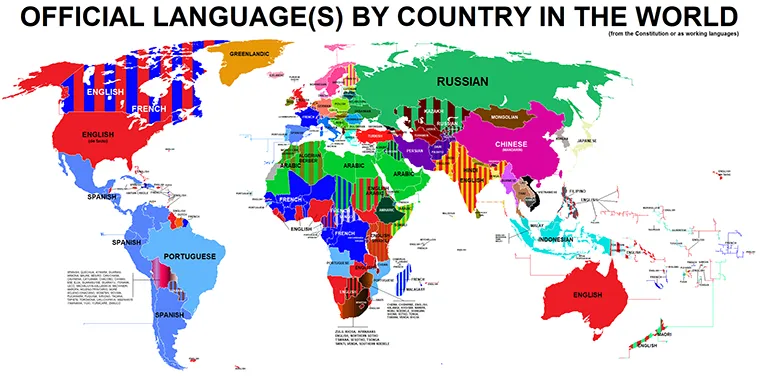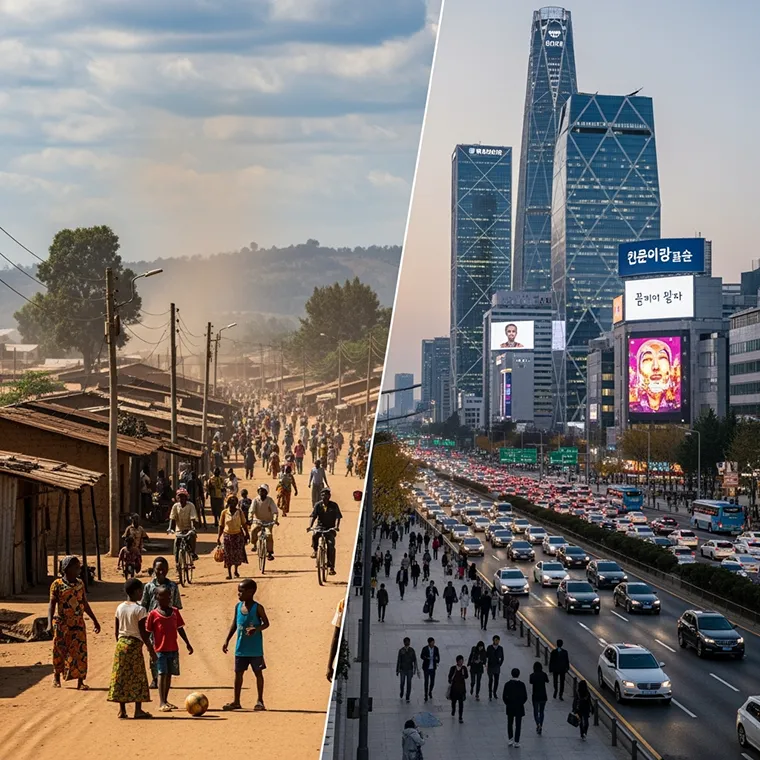Loosening the Linkages Between Language and the Land
by Lifeboat Foundation Advisory Board members Lawrence Baines and Gul Nahar.
Abstract
Like any living thing, languages evolve over time. This paper examines the connections among sociocultural change, access to the Internet, and the fluctuations of English as a global language. English has begun to transcend geographical borders and sociocultural boundaries as its status as a national language, official language, or unofficial language grows. Connections among various phenomena, such as Internet penetration, language policy, and linguistic diversity, and economic well-being, are analyzed. Countries discussed include South Korea, the Democratic Republic of the Congo, Tanzania, Tunisia, Japan, and China.
The rush of governments worldwide to connect their citizens to the mobile Internet and to adopt English as a language of commerce comes with the expectation that an enhanced quality of life will be an inevitable outcome. However, the proliferation of English as a global language and the widespread adoption of the Internet are transmogrifying the roles of indigenous languages and local customs. The contention of the authors is that these transformative events — the global spread of English and the proliferation of the Internet — are loosening the historically durable ties between the geography of a region and the language and customs of the people who live there.
Language and Geography

Traditionally, languages have been defined in geographic terms. The assumption always has been that words and meanings are inextricably connected to the land and its people. The names of language families, themselves, are reflective of the geography of the regions where languages were born and have thrived.
The Indo-European family of languages, for example, include over 400 languages and dialects and are associated with current-day Europe and parts of Asia, including India (Haak et al. 2015). The largest language family on the continent of Africa in terms of geographic area is Niger-Congo, which includes about 1400 languages and is associated with the countries of Central and Southern Africa (Niger-Congo languages 2015).
About the link between language and geography, Chambers (2000: 170) writes:
Eighteenth century philosophers believed that language was a natural, organic entity, like a plant, and its diversity was thought to have the same source as the diversity of vegetation. Just as vegetable life took on distinctly different appearances according to the climate and soil that nourished it, so languages took on distinctly different characteristics in different climates.
With the advent of mass transportation and the proliferation of mobile, global communications, the connection between language and the land may be loosening. Today, two of every seven persons on planet Earth speak English, and the number seems likely to increase over the next 50 years (Baines 2012; Westcombe 2011). Needless to say, it is difficult to substantiate the proliferation of English using arguments solely predicated upon national boundary lines or physical features of a landscape.
In the country of South Korea in East Asia, for example, English is widely spoken and taught in schools, though the country shares no borders with countries where English is the primary language. Of course, the US military, along with the United Nations Peacekeeping Forces, worked with the government of South Korea during the Korean War, 1950–1953. However, South Korea has no history of colonization by English-speaking people, other than a trickle of religious evangelists (Chung 2014).
English in East Asia

In many countries of East Asia, proficiency in English is viewed as a gateway to economic success. English proficiency is considered desirable by most citizens who want a higher standard of living and by national governments attempting to promote growth and financial stability. For better or worse, the presence of English language education in East Asian countries pits the rewards associated with increased trade against the preservation of native languages, cultural identity, and local traditions.
Since the 1970s, the initiative to integrate English language instruction into the Chinese educational system has been a priority for the central government’s modernization agenda (Hu and McKay 2012).
China’s Ministry of Education has already mandated formal primary English instruction beginning in the elementary years, but recent initiatives have expanded English instruction into kindergarten, where bilingual classes are now offered in a variety of venues (Feng 2005; Deloitte China Research and Insight Center 2014). At the same time, Chinese universities have begun to offer courses exclusively in English (Yan et al. 2015).
In 2013, there were over 50,000 English language schools in China, and the English language learning industry in China generated about 5 billion dollars (Adkins 2014: 9). Incredibly, with as many as 400 million English language learners in China, there may be more speakers of English in China than in the United States (Wei and Jinzhi 2012).
In Japan, English is viewed as a necessary second language for participation in both business and research. As a result, English as a course of study has customarily begun in fifth grade in Japan and has continued well into the university curriculum. However, the Japanese Ministry of Education, Culture, Sports, Science, and Technology (MEXT) recently has announced that the teaching of English will commence even earlier — in grade 3 — to insure better English language acquisition at an earlier age (Yoshida 2013).
About the explosive advance of English in East Asia, Education First (2015: 27), an organization that publishes an annual report that rates countries in terms of their adoption of English, reports that:
Since 2007, Asia’s adult English proficiency has improved more than any other region. With half of the world’s population, Asia has wide-ranging levels of proficiency…. With their increasingly international economies, Asian countries invest in English training as a tool for accelerating globalization.
In countries of at least five million in population, the top 8 most prosperous countries in the world in terms of per person income are all predominantly English-speaking, as noted in Table 1.
Country |
Rank in GNIPPb |
2014 GNIPP |
Population |
% who speak English |
|---|---|---|---|---|
Norway |
1 |
103,050 |
5.2 million |
90 |
Australia |
2 |
64,680 |
24 million |
97 |
Sweden |
3 |
61,600 |
9.8 million |
86 |
Denmark |
4 |
61,310 |
5.7 million |
86 |
United States |
5 |
55,200 |
94 |
|
Singapore |
6 |
55,150 |
5.6 million |
80 |
Canada |
7 |
51,690 |
36 million |
86 |
Netherlands |
8 |
51,210 |
17 million |
90 |
Japan |
13 |
42,000 |
127 million |
50+ (proficiency varies widely) |
South Korea |
17 |
27,090 |
49 million |
50+ (proficiency varies widely) |
|
aIncludes countries with at least five million inhabitants plus Japan and South Korea; Atlas Method; 2015 US dollars. bAccording to Global Finance Magazine (2015), gross national income per person is “gross national income divided by population” and is used as a relative wealth index for citizens of a country. |
||||
Although Japan and South Korea are not in the top 8 in terms of GNIPP, both countries are economic powerhouses and are among the top 20. The percentage of English speakers in both countries has expanded markedly over the past 30 years, with younger citizens increasingly more proficient in English than their elders (Kim and Kim 2011).
The lowest-ranked countries in the world with regard to GNI per capita are listed in Table 2. Notably, none of the bottom-eight countries are located in Asia nor is English widely spoken in any of them.
Country |
Rank in GNIPP (186 countries) |
2014 GNIPP |
Population |
% who speak English |
|---|---|---|---|---|
Central African Republic |
Last |
600 |
5 million |
0–1 |
Democratic Republic of the Congo (DRC) |
Next to last |
650 |
77 million |
0–1 |
Burundi |
Third from last |
770 |
9.8 million |
0–1 |
Malawi |
Fourth from last |
790 |
16 million |
4 |
Niger |
Fifth from last |
920 |
0–1 |
|
Guinea |
Sixth from last |
1120 |
11 million |
0–1 |
Mozambique |
Seventh from last |
1140 |
26 million |
0–1 |
Togo |
Eighth from last |
1290 |
7.3 million |
0–1 |
|
aIncludes countries with at least five million inhabitants; Atlas Method; 2015 US dollars |
||||
It is only natural for nations who wish for greater economic development to infer a causal relationship between the ability of a country’s population to speak English and the relative wealth of the populace. Indeed, the data in Tables 1 and 2 seem to indicate a strong correlation between prosperity and large numbers of citizens who are conversant in English.
To get a better sense of how English might function as an official second language within an East Asian country, a more in-depth examination of South Korea may prove illuminating. Indeed, South Korea seems to have adopted English as a logical policy choice, with the express objectives of promoting innovation and making money. According to Nicholson (2015: 13), the English language in South Korea is not “imperialistic,” but is “pragmatic,” and related to “purposes of international business communication and academic advancement.”
It was not so long ago that South Korea was considered a “developing country” (Connolly and Yi 2008). In 1961, South Korea’s gross domestic product per capita was only $91 (World Bank 2015a), significantly less than Sri Lanka ($143), Peru ($273), and less than one-fifth of the GDP per capita of the Democratic Republic of the Congo ($563). By 2014, South Korea’s gross domestic product per capita had grown to $27,970, which was comparable to the output of France or Japan and surpassed the Democratic Republic of the Congo ($1429), Sri Lanka ($3631), and Peru ($6551) by significant margins. Although there are many factors involved in South Korea’s stunning economic ascent, technology and language have been critical, unifying factors for the country.
In addition to the Korean language, the study of English is a required course for Korean students every year, from grade 3 to grade 12 (Korean Ministry of Education 2015). Hadid (2014) found that Koreans spend on average “$15 billion on private English education, with 17,000 English cram schools (known as hagwons) scattered across the nation and an army of 30,000 native English teachers, along with thousands more who teach English illegally.” Today, over half of Koreans under the age of 40 understand basic English, and 10% consider themselves fluent (Hadid 2014), a marked contrast to a few decades ago when almost no South Koreans, outside of military advisors to the United States, spoke English (Kim and Kim 2011).
In addition to the adoption of English, South Korea has made deep monetary and policy commitments to technology. As a result, South Koreans are among the highest users of the Internet on the planet, and the country’s technological sector has become one of the world’s most formidable in terms of productivity and distribution (World Bank 2015a). The proliferation of technology and the elevation of the English language have helped speed the sociocultural transformation of South Korea from an “impoverished nation just out of war” to a flourishing world power in less than a half-century (Da-ye 2012).
The Technological Infrastructure of the Internet

Arpanet (Advanced Research Projects Agency Network) was the original Internet, developed by the Department of Defense in the United States. As a result of its American origins, the infrastructure of the Internet was written in English-based code, as are the vast majority of programming languages that proliferate on the Internet today. English is so prevalent as the language of the Internet that developers from all over the world are as likely to consult English style handbooks as highly technical programming manuals. Ford (2015) writes:
Style and usage matter; sometimes programmers recommend Strunk and White’s The Elements of Style — that’s right, the one about the English language. Its focus on efficient usage resonates with programmers. The idiom of a language is part of its communal identity.
Of the more than 30 trillion web pages on the Internet, about 56% are in English, while only 6% are in German, 5% in Japanese, and 3% in Chinese (Phillips 2015). According to The Economist (2015: 5), “American firms now host 61% of the world’s social-media users, undertake 91% of its searches and invented the operating systems of 99% of its smartphone users.” Along with the Internet’s infrastructure and the litany of programming languages, the words used to communicate on the Internet are likely to be English, as well.
The impact of an English-based Internet has had fascinating effects
on other languages. Arabizi, for
example, is a system of writing in Arabic that uses Latin-type letters
rather than Arabic script. The word Because
of the ubiquity of QWERTY keyboards and the “westernized” nature of
interfaces on the Internet, speakers of Chinese have adapted their
communications by writing in pinyin, which uses the Latin alphabet as a
vehicle to communicate in Chinese (Information Today 1998).
In actuality, pinyin was introduced by China’s revolutionary government
in 1958, and its original use was as a way to teach “correct sounds and
tones” to young children before introducing the complexities of writing
Chinese characters by hand (Byrne 2007: 201). However, pinyin has become the lingua franca of Chinese on the Internet. Unfortunately,
much recent research substantiates that an increasing reliance on the
Roman-based pinyin system has had deleterious effects on the ability of
Chinese children to write Chinese characters (Tan et al. 2013; The Economist 2014). Despite the alarm over “character amnesia,” according to Mair (2012),
the Chinese language is not dying but adapting. A Chinese interlocutor
who writes to a friend will probably write in pinyin. A Chinese
interlocutor who composes a text in Mandarin for a professor of Chinese
literature will probably use carefully chosen Chinese characters. The top 18 countries in the world (with a population of at least five
million citizens) in terms of Internet connectivity are shown in Table
3. Rank Country Users per 100 people % who speak Englishb 1 Norway 96.3 90 2 Denmark 96.0 86 3 Netherlands 93.2 90 4 Sweden 92.5 86 5 Finland 92.4 70 6 United Kingdom 91.6 98 7 Japan 90.6 50 8 90.4 80c 9 United States 87.4 94 10 Canada 87.1 86 11 Switzerland 87.0 61 12 Germany 86.2 64 13 Belgium 85.0 59 14 Australia 84.6 97 15 South Korea 84.3 50 16 France 83.8 39 17 Singapore 82.0 80 18 Austria 81.0 73 aIncludes
countries with over five million persons bEducation
First (2015), European Commission (2012), Ethnologue (2015), and
Nicholson (2015) cThis data was
taken from Arab Social Media Report (2012); however,
it is important to note that, since 80% of the UAE population at any
point in time might be comprised of immigrants, this percentage is only
an estimate The connection between technology
and the English language is evident in the number of countries listed
in Table 3 where English is dominant. Note that 13
of the 18 most connected nations in the world have 70% or more English
speakers. In the other five countries, 39–64% of residents are
able to communicate in English. That the
English language and technological innovation have become associated
with economic development has not gone unnoticed. Since 2007, the
government of Tanzania, for example, has tried to speed the adoption of
technological devices among its citizens through the exemption of taxes
on imported technology equipment (Sife et al. 2007), one of the strategies often utilized by the
South Korean government to promote technology spending. The government
of Tanzania has also sponsored the development of SEACOM, an
optic-fiber, marine cable that has increased bandwidth and reduced
telecommunication costs by 95% for Tanzanian citizens (Swarts and
Wachira 2010; Lwoga 2012).
While many Africans have no access to the Internet (the bottom-eight
countries in Table 3 are all from Africa), as many
as 20% of Tanzanians could access the Internet in 2013, which
represents rapid growth in only a few years (Mtweve 2014). Currently, in Tanzania, most residents
speak Kiswahili, and only a small percentage of the population speaks
English. Despite the adoption of Kiswahili as the national language,
English has become the language of the educated elite (Hillard 2015). Tanzanians who speak English often have some
affiliation with expensive, private schools in the country, who deliver
the curriculum almost exclusively in English. To encourage more
Tanzanians to develop competency in English, the government has
instituted a series of policies, including the edict that high schools
and postsecondary institutions must use English as the basic language
of instruction. About the edict to begin teaching courses in English,
Qorro (2013) notes that one problem might be that
most students are unfamiliar with the language: A second difficulty with delivering
courses in English is, of course, that proficiency in English is
presumed of Tanzanian teachers. However, surveys of English language
proficiency among Tanzanian teachers have revealed that a large
percentage struggle to speak or write in English and, thus, would be
unable to coherently convey the content of their subject matter to
students in English (Nunan 2003; Qorro 2013). As most Tanzanians speak a local dialect
as a first language, Kiswahili and English act as the second and third
languages, respectively. However, because 95% of the population is
fluent in Kiswahili (Brock-Utne and Holmarsdottir 2004), at least there is a common language from which
to launch a move to English. The lack of a unifying, national first
language makes conversion to any second language exponentially more
difficult (more about this in the discussion of the Democratic Republic
of the Congo below). Undeniably, the rise of English is affiliated with
increased wealth, though it simultaneously imperils the 120 dialects
spoken by different groups in Tanzania (Hardman et al. 2012). Tunisia is yet another example of an
African country that is moving toward English, while its native and
colonial languages are in flux. Three thousand years ago, the people of
the geographic area that is now Tunisia spoke Berber, Punic, and Latin.
With the spread of Islam in the eighth century, Arabic became the
dominant language, gradually replacing Berber and other languages and
dialects. Today, Berber is spoken by less than 1% of Tunisians (Daoud
2011). During the period in which Tunisia was a
French Protectorate (1881–1956), the French language surged,
becoming the default second language, behind Arabic (Gibson 2013). Today, English is systematically becoming
integrated into the culture of multilingual Tunisia. In fact, English
has become a mandatory subject in the school curriculum from the sixth
grade on. The use of English in Tunisian society is conspicuous in
science, technology, economics, and social sciences (Daoud 2011). Increasingly, younger Tunisians and academics
are using the English language, rather than Arabic or French, to
discuss contemporary intellectual, political, and social issues
(Labassi 2008). It is no accident that the plethora
of tweets and instant messages sent by Tunisians during the intense
months of the Arab Spring in 2011 were mostly written in English (Bruns
et al. 2013). Perhaps the most interesting case study in
Africa at this moment in time is the Democratic Republic of the Congo,
formerly known as the Republic of Zaire. Incredibly, the per capita
gross domestic product of the DRC was five times that of South Korea in
1961, but the DRC has since lost its advantage (World Bank 2015c). In 2013, the country was rated 186th of 187
countries by the United Nations in terms of human development. Almost
nine of ten citizens live in severe poverty, which means that they live
on less than $1.25 per day. The DRC ranks relatively low in terms of
literacy but high in terms of death rates, income inequality,
discrimination, and crime (United Nations Human Development Index 2013). Researchers from the World Bank (2015b) note:
As in
Tunisia, French is the official language of the DRC, though over 200
languages are spoken and there are four additional
“national” languages: Lingala, Kingwana (another dialect of
Swahili), Kikongo, and Tshiluba (World Factbook 2015). According to the Language Education Policy
Studies website (2015), in the DRC:
Although French is the language of
the government, courts, and commerce, only about one in three of
DRC’s citizens actually speak French (Organisation Internationale
de Francophonie 2015). While South Korea
has one of the highest Internet penetration rates in the world, the DRC
has one of the lowest (Internetlivestats 2015;
World Bank 2015b). Table 4
compares South Korea and the Democratic Republic of the Congo in terms
of population, land area, income, English speakers, and Internet
penetration. The top 18 countries in the world (with a population of at least five
million citizens) in terms of Internet connectivity are shown in Table
3. There
seems to be universal agreement that, at least in terms of natural
resources, the Democratic Republic of the Congo is one of the richest
countries on Earth (World Factbook 2015; World Bank
2015c). In comparison, Korea, despite having 30
million fewer people, scarcer natural resources, and less than 5% of
the land mass, has a per capita gross national product that is 64 times
greater. Obviously, South Korea’s technological infrastructure
and economic development have grown at far faster rates than those of
the DRC. In addition, South Koreans communicate using a single,
unifying language – Korean, with English as a de facto secondary
language, a widely adopted language of commerce and academics. Not only
are many courses delivered in English in K–12 schools in South
Korea, current president Park Geun-hye often makes political speeches
to her constituents in English (Davis 2015). In the Democratic Republic of the Congo,
languages and personal identities are far more convoluted. Citizens in
some areas may not be able to comprehend the language of citizens who
live only a short distance away. In light of the expansion of English
as the global language of commerce, English as an official language was
considered by the government of the DRC in 2010, but the idea has never
been taken seriously as a potential policy change (Kasanga 2012). The diversity of languages has impeded
communication within the country as well as slowed trade and diplomatic
relations with other nations. As a result, the Democratic Republic of
the Congo is one of the poorest countries in the
world. Developing countries worldwide are
considering adopting English as an official language or, at least,
encouraging its widespread use. Pinon and Haydon (2010: 5) note the assumptions of financial rewards
implicit in the adoption of English by developing countries, even if it
means the denigration of native dialects and the evisceration of
colonial languages, such as French or Spanish: Creating governmental policies to
promote English as an official language does not automatically
translate into increased wealth and satisfaction. The Republic of
Liberia, with a population of 4.5 million, is one of the poorest
countries in the world, though as many as 20% of Liberians speak
English (World Factbook 2015). Despite the
inconclusive evidence on behalf of English as a liberating,
money-generating language, resistance to its spread may be futile.
Education First (2015: 4) notes that the connection
between English and economic well-being has become an entrenched
belief: Once upon a time, geography
and the exigencies of travel had significant delimiting effects upon
language and communication. People who were born and grew up in a
remote village in New Guinea, for example, would seldom leave the
geographic area associated with their settlement for two very good
reasons:
The residents of other villages might not understand them. The residents of the other villages might
try to kill them (Diamond 2012). According
to the Groupe Speciale Mobile Association (2014:
3), the number of persons who will have access to the mobile Internet
will rise to 3.8 billion — more than half of the world’s
population — by 2020. The continued expansion of the
English-language-based Internet to an ever wider global market will
only accentuate the desirability, if not urgency, of learning the
language. Worries over the spread of English abound, chief among
them the demise of language diversity and the potential dilution of
local traditions. According to a UNESCO report on endangered languages,
“A language disappears when its speakers disappear or when they
shift to speaking another language — most often, a larger
language used by a more powerful group” (UNESCO 2015). Over the next few decades, hundreds of
languages are expected to disappear forever, and the rate of extinction
is expected to accelerate (Baines 2012; Harrison 2007). If, as prognosticated, the world begins
moving to the Internet of Things and machines are networked so that
they communicate with each other continually, then the operation of
many aspects of our lives, “from streetlights to seaports,”
would depend upon effective machine communication (Burrus 2014). It seems inevitable that the language of these
powerful machines and the language acceptable to their human/machine
interface will be some form of English. Kornai (2013: 10) writes: Herscovitch (2012) comments: The future of
communications is the Internet and the language of the Internet is
English. However, even English is changing, morphing into Leetspeak (a
computerized English slang), Chinglish (Chinese and English), Spanglish
(Spanish and English), Babu English (Bengali and English), and Sheng
(Swahili and English). Language evolves to suit the purpose of the
messenger. As the Internet removes the obstacle of distance and the
rules for global conversation become increasingly standardized through
English, the influence of geography on language will continue to
weaken. Adkins, S. (2014). The 2013–2018 China digital English language learning market (Ambient Insight Country Report). Monroe: Ambient Insight. Retrieved from http://www.ambientinsight.com/Resources/Documents/AmbientInsight-2013-2018-China-Digital-English-Language-Learning-Market-Abstract.pdf. Arab Social Media Report. (2012). Social media in the Arab world: Influencing societal and cultural change? Dubai: Dubai School of Government. Google Scholar Baines, L. A. (2012). A future of fewer words? The Futurist, 46(2), 42–47. Google Scholar Brock-Utne,
B., & Holmarsdottir, H. B. (2004). Language policies and practices
in Tanzania and South Africa: Problems and challenges. International Journal of Educational Development, 24(1), 67–83. CrossRef Google Scholar Bruns,
A., Highfield, T., & Burgess, J. (2013). The Arab spring and social
media audiences: English and Arabic Twitter users and their networks. American Behavioral Scientist, 57(7), 871–898. CrossRefGoogle Scholar Burrus, D. (2014). The Internet of things is far bigger than anyone realizes. Wired. Retrieved from http://www.wired.com/insights/2014/11/the-internet-of-things-bigger/. Byrne, G. (2007). Schooling and learning difficulties in China. Contemporary Review, 289(1685), 201–208. Google Scholar Chambers, J. (2000). Region and language variation. English World-Wide, 21(2), 169–199. CrossRef Google Scholar Chung, B. J. (2014). A reflection on the growth and decline of the Korean Protestant Church. International Review of Mission, 103(2), 319–333. CrossRef Google Scholar Connolly, M., & Yi, K.-M. (2008). How much of South Korea’s growth miracle can be explained by trade policy? Philadelphia: Federal Reserve Bank. Retrieved from http://www.frbsf.org/publications/economics/papers/2008/wp08-23bk.pdf. Google Scholar Daoud, M. (2011). The sociolinguistic situation in Tunisia: Language rivalry or accommodation? International Journal of the Sociology of Language, 2011(211), 9–33. CrossRef Google Scholar Davis, J. H. (2015, October 16). Obama and South Korean leader emphasize unity. The New York Times. Retrieved from http://www.nytimes.com/2015/10/17/world/asia/park-geun-hye-washington-visit.html. Da-ye, K. (2012, October 7). How far can English go? The Korea Times. Retrieved from http://koreatimes.co.kr/www/news/biz/2012/10/602_121658.html. Deloitte China Research and Insight Center. (2014). Report on the diversification of China’s education industry. Shanghai: Deloitte China. Google Scholar Diamond, J. (2012). The world until yesterday: What can we learn from traditional societies? New York: Viking. Google Scholar Economist, The. (2014, August 23). Bad characters: Some Chinese forget how to write. Retrieved from http://www.economist.com/news/china/21613300-some-chinese-forget-how-write-bad-characters. Economist, The. (2015, October 3–9). American, the sticky superpower: A special report, 1–16. Google Scholar Education First. (2015). Education first English proficiency index. Retrieved from www.ef.com/epi. Ethnologue: Languages of the World. (2015). Open language archives in and about the English language. Retrieved from http://www.language-archives.org/language/eng. European Commission. (2012). Europeans and their languages report, special Eurobarometer 386. Retrieved from http://ec.europa.eu/public_opinion/archives/ebs/ebs_386_en.pdf. Feng, A. (2005). Bilingualism for the minor or the major? An evaluative analysis of parallel conceptions in China. International Journal of Bilingual Education and Bilingualism, 8(6), 529–551. CrossRef Google Scholar Ford, P. (2015, June 11). What is code? Bloomsberg Businessweek. Retrieved from http://www.bloomberg.com/graphics/2015-paul-ford-what-is-code/. Gibson, M. (2013). Dialect leveling in Tunisian Arabic: Towards a new spoken standard. In A. Rouchdy (Ed.), Language contact and language conflict in Arabic: Variations on a sociolinguistic theme (pp. 24–40). New York: Routledge. Google Scholar Global Finance Magazine. (2015). Definition of GNI per capita. Retrieved from https://www.gfmag.com/global-data/glossary/gdp-gni-definitions. Groupe Speciale Mobile Association. (2014). Digital inclusion. London: GSMA. Google Scholar Haak,
W., Lazaridis, I., Patterson, N., Rohland, N., Mallick, S., Llamas, B.,
& Khokhlov, A. (2015). Massive migration from the steppe was a
source for Indo-European languages in Europe. Nature, 522(7555), 207–211. CrossRefGoogle Scholar Hadid, A. (2014, June 29). The future of English in Korea. The Diplomat. Retrieved from http://thediplomat.com/2014/06/the-future-of-english-in-korea/. Hardman, F. C., Abd-Kadir, J., & Tibuhinda, A. (2012). Reforming teacher education in Tanzania. International Journal of Educational Development, 32, 826–834. CrossRef Google Scholar Harrison, K. D. (2007). When languages die: The extinction of the world’s languages and the erosion of human knowledge. New York: Oxford University Press. CrossRef Google Scholar Herscovitch, B. (2012, September 12). English is the language of the Asian century. The Drum. Retrieved from www.abc.net.au/news/2012-09-13/herscovitch-english-asia/4257442. Hillard. (2015). Tanzanian students’ attitudes toward English. TESOL Journal, 6(2), 252–280. CrossRef Google Scholar Hu, G., & McKay, S. L. (2012). English language education in East Asia: Some recent developments. Journal of Multilingual and Multicultural Development, 33(4), 345–362. CrossRef Google Scholar Information Today. (1998). Library of Congress intends to convert to Pinyin system for Romanization of Chinese. Information Today, 15(1), 42. Google Scholar Internetlivestats (2015). Internet users by country (2014). Retrieved from www.internetlivestats.com/internet-users-by-country/. Kasanga, L. (2012). English in the Democratic Republic of the Congo. World Englishes, 31(1), 48–69. CrossRef Google Scholar Kim, K., & Kim, K. (2011). English in South Korea: Yesterday and today. In M. Koehler & P. Mishra (Eds.), Proceedings of society for information technology and teacher education international conference 2011 (pp. 2873–2882). Chesapeake: Association for the Advancement of Computing in Education (AACE). Google Scholar Korean Ministry of Education. (2015). National basic curriculum. Retrieved from http://english.moe.go.kr/web/1695/site/contents/en/en_0205.jsp. Kornai, A. (2013). Digital language death. PLoS One, 8(10), e77056, 1–11. CrossRef Google Scholar Labassi, T. (2008). On responsible uses of English: English for emancipation, correction and academic purposes. Changing English: Studies in Culture and Education, 15(4), 407–414. CrossRef Google Scholar Language
Education Policy Studies website. (2015). Language education policies
in the Democratic Republic of the Congo. Retrieved from http://www.languageeducationpolicy.org/lepbyworldregion/africacongo.html. Lwoga, E. (2012). Making learning and Web 2.0 technologies work for higher learning institutions in Africa. Campus-Wide Information Systems, 29(2), 90–107. CrossRef Google Scholar Mair, V. (2012, August 30). Creeping romanization in Chinese. Language Log. Retrieved from http://languagelog.ldc.upenn.edu/nll/?p=4157. Mtweve, S. (2014, March 23). Tanzania’s Internet users hit 9 m. The Citizen. Retrieved from http://www.thecitizen.co.tz/Business/Tanzania-s-Internet-users-hit-9m/-/1840414/2254676/-/dgt0ps/-/index.html. Nicholson, S. (2015). English as an international language: A functional role in South Korea. Journal for the Study of English Linguistics, 3(1), 13–27. CrossRef Google Scholar Niger-Congo languages. (2015). In Encyclopedia Britannica. Retrieved from http://www.britannica.com/topic/Niger-Congo-languages. Nunan, D. (2003). The impact of English as a global language on educational policies and practices in the Asia-Pacific region. TESOL Quarterly, 37, 589–613. CrossRef Google Scholar Organisation Internationale de Francophonie. (2015). Democratic Republic of the Congo. Retrieved from http://www.francophonie.org/Congo-RD.html. Phillips, J. (2015, May 1). The Internet’s most popular languages. Brightlines. Retrieved from http://www.brightlines.co.uk/en-gb/brightlines/blog/2015/5/1/the-internets-most-popular-languages/. Pinon, R., & Haydon, J. (2010). English language quantitative indicators: Cameroon, Nigeria, Rwanda, Bangladesh and Pakistan. London: British Council. Retrieved from https://www.teachingenglish.org.uk/sites/teacheng/files/Euromonitor%20Report%20A4.pdf. Google Scholar Qorro, M. (2013). Language of instruction in Tanzania: Why are research findings not heeded? International Review of Education, 59(1), 29–45. CrossRef Google Scholar Sife,
A. S., Lwoga, E. T., & Sanga, C. (2007). New technologies for
teaching and learning: Challenges for higher learning institutions in
developing countries. International Journal of Education and Development using Information and Communication Technology (IJEDICT), 3(2), 57–67. Google Scholar Swarts,
P.,, & Wachira, E. (2010). Tanzania: ICT in education situational
analysis. Global e-schools and communities initiative. Retrieved from http://www.gesci.org/assets/files/KnowledgeCentre/SituationalAnalysis_Tanzania.pdf. Tan,
L., Xu, M., Chang, C., & Siok, W. (2013). China’s language input
system in the digital age affects children’s reading development. Proceedings of the National Academy of the Sciences of the United States of America, 110(3), 1119–1123. CrossRefGoogle Scholar UNESCO. (2015). Endangered languages: Frequently asked questions on endangered languages. Retrieved from http://www.unesco.org/new/en/culture/themes/endangered-languages/faq-on-endangered-languages/. United
Nations Human Development Index. (2013). Congo (Democratic Republic of
the) HDI values and rank changes in the 2013 human development report.
Retrieved from http://hdr.undp.org/sites/default/files/Country-Profiles/COD.pdf. Wei, R., & Jinzhi, S. (2012). The statistics of English in China. English Today, 28(3), 10–14. CrossRef Google Scholar Westcombe, J. (2011, September). English – a status report. Spotlight: Das Magazin fur Englisch (pp. 28–33). http://archiv.spotlight-online.de/files/spotlight/Magazine_content/Documents/spotlight_0911_28_30_crystal.pdf. World Bank. (2015a). Public data: World development indicators, GDP per capita for Japan, Korea, Peru, and Democratic Republic of Congo. World Bank. (2015b). Internet users (per 100 people). Retrieved from http://data.worldbank.org/indicator/IT.NET.USER.P2. World Bank. (2015c). Democratic Republic of the Congo: Social context. Retrieved from http://www.worldbank.org/en/country/drc/overview. World Bank. (2015d). GNI per capita, PPP (current international $). Retrieved from http://data.worldbank.org/indicator/NY.GNP.PCAP.PP.CD?order=wbapi_data_value_2014+wbapi_data_value+wbapi_data_value-last&sort=desc. World Factbook. (2015). Democratic Republic of the Congo. Retrieved from https://www.cia.gov/library/publications/the-world-factbook/geos/cg.html. Yaghan, M. A. (2008). “Arabizi”: A contemporary style of Arabic slang. Design Issues, 24(2), 39–52. CrossRef Google Scholar Yan,
E., Fung, I., Liu, L., & Huang, X. (2015). Perceived
target-language-use survey in the English classrooms in China:
Investigation of classroom related and institutional factors. Journal of Multilingual and Multicultural Development. https://doi.org/10.1080/01434632.2015.1029934. Yoshida, R. (2013, October 13). Required English from third grade eyed. Japan Times. Retrieved from http://www.japantimes.co.jp/news/2013/10/23/national/required-english-from-third-grade-eyed/#.VMviRXB4rzE).…due
to the advancement of the Internet and the global use of the English
language (and without any imperialistic implications) the use of Latin
letters to write Arabic over the Internet and on text-messaging cellular
phones is becoming increasingly common and natural.
English and Technology in Africa

Despite the sociolinguistic context in which
Kiswahili dominates, the current language in education policy, which is
in operation in 2012, stipulates that English remains LOI [Language of
Instruction] for secondary school and tertiary education. This means
99.1 per cent of pupils who join secondary education coming from a
primary school where Kiswahili was the LOI have to switch to
English.
A Study in Contrasts: The Democratic Republic of the Congo (DRC) and
South Korea

There
are some 2.3 million displaced persons and refugees in the country and
323,000 DRC nationals living in refugee camps outside the country. A
humanitarian emergency persists in the more unstable parts of the DRC
and sexual violence rates remain high.
…ethnic languages are used primarily within
families, as well as within ethnic groups. The national languages serve
as ‘regional vehiculars,’ especially in urban areas….
French, in turn, is used in all ‘official’ domains, in
particular in the government and
judiciary.
English as a Worldwide Phenomenon

Nigeria, Pakistan, Bangladesh and Cameroon all
have a wide variety of indigenous languages and are seeking to develop
a degree of linguistic unity through the use of English. Rwanda’s
native language, Kinyarwanda, is spoken by 98% of the population.
Furthermore, its government is looking to achieve greater harmony with
English-speaking East African countries, while turning away from
French-speaking West African nations. These trends reflect the growing
awareness that strong English skills are a requirement to develop a
competitive economic advantage in the global
economy.
Few countries continue to
debate whether or not English should be taught. Instead, discussions of
English instruction in public schools focus on which dialect of English
is taught, how it is assessed, and how much English education is
necessary….English is often tied to development goals, expansion of
the service sector, and increased connectivity to the rest of the
world.
Conclusion
What we are witnessing is not just a massive
die-off of the world’s languages, it is the final act of the
Neolithic Revolution, with the urban agriculturalists moving on to a
different, digital plane of
existence.
Nearly one-third of the world’s population
is studying English, and it is predicted that by 2050, half of the
world’s population will be largely proficient in it. Added to
this, four of the six most populous countries in the world in 2050
(India, the United States, Nigeria and Pakistan) will have English as
an official language.
References